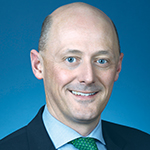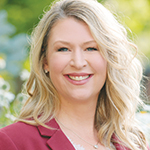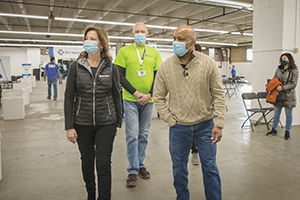By LISA EISENHAUER
Two doctors who are part of a group of medical leaders in Colorado that has been jointly confronting the COVID-19 pandemic are hopeful the collaboration among competitors will continue long after the virus is vanquished.

Valin
Dr. J.P. Valin, chief clinical officer for SCL Health, and Dr. Shauna Gulley, senior vice president and chief clinical officer at Centura Health, started meeting every weekday by teleconference with their counterparts from five other large health systems in March 2020, as the pandemic was beginning to rage. A representative from the Colorado Hospital Association joined them.
"We collectively decided that the COVID-19 pandemic response was bigger than any one physician, or any one hospital or any one health system and it was going to take us all moving in concert to get the best possible patient care and the best possible outcomes for the state of Colorado," Gulley says.

Gulley
Over the last year, the physician leaders have pooled data on topics like infection rates, patient admissions and staffing. They have hashed out and jointly set policies on masking, visitation and staff redeployment. They have established processes to share resources like personal protective equipment and testing capabilities.
The group touted their efforts in a commentary titled "Physician Executives Guide a Successful Covid-19 Response in Colorado" that was published online by NEJM Catalyst last fall. The partnership, the doctors wrote, "ultimately allowed our state to rapidly de-escalate the rates of infection, hospitalization, and mortality due to COVID-19."
Responding to a clinical crisis
Valin says the impetus for the group came from chief executives of the health care systems, which also included Banner Health, Boulder Community Health, Denver Health, UC Health and HCA Healthcare/Health ONE. The executives saw the medical leaders as having the best skills to get the systems through a looming clinical crisis that initially there were no therapeutics or interventions to address, he says.

Dr. J.P. Valin, center, chief clinical officer for SCL Health, tours the site of a mass COVID-19 vaccination event in Denver with Lydia Jumonville, the system's president and chief executive, and Denver Mayor Michael B. Hancock. Five thousand people got their shots during the event.
In their commentary, the physician leaders defined their collective goal as "to identify issues, share best practices, align on difficult decisions, and provide guidance" on how to tackle the unprecedented challenges posed by the pandemic.
Valin says having the health systems aligned in their policies made working together simpler since they were all going by the same playbook. Their alignment also reassured staff and the public because health care leaders weren't sending out mixed signals on practices such as masking and social distancing.
Through their collaboration, Valin says the hospital systems put the best interest of all Coloradans ahead of their own self-interests.
He says, for example, that early on the systems with their own COVID testing capabilities had a clear advantage over those relying on outside labs that could take days to return results. The physician leaders in the group agreed that the in-house testing capabilities would be used to test the sickest of patients, regardless of where they were being treated, to determine whether they had the virus. "Those systems could have used their testing capabilities to get a competitive edge," Valin notes.
Improved outcomes
In addition to working together on behalf of their systems, the physician leaders collaborated with state officials leading the emergency pandemic response. They relayed concerns from frontline health workers and advised on public policy decisions, such as guidelines for reopening public places and allocation of scarce medical resources.
The physician leaders came from a range of specialties including emergency medicine, anesthesiology, family, internal and hospital medicine, infectious diseases, and pediatrics. This gave the overall group a broader perspective on the challenges COVID care presented, Valin says. He says some of the doctors in the collaboration were participating in the day-to-day care of COVID patients and witnessing the toll that effort was taking on frontline staff.
The health systems the physicians represented cared for 98% of patients hospitalized with COVID complications in the state from March to July 2020. In their commentary, the doctors credit their collaborative efforts for clinical outcomes that were better than the national average, including lower overall mortality rates, lower average lengths of stay, and fewer patients requiring mechanical ventilation.
Gulley says that though the commentary focused on the group's efforts early in the pandemic, the collaboration has continued to serve the systems well. She cites as one of its top achievements setting up a statewide transfer center that kept track of open beds across all the systems so staff at an overwhelmed hospital would know where they could send patients. She adds the process "worked seamlessly" when COVID cases surged later in the year.
The health systems' collaboration has made vaccine distribution much smoother, Gulley says. The physician leaders worked together to get frontline workers inoculated and to set up clinics to give shots to the public.
Next challenge
While they are still videoconferencing on their COVID response twice a week, the physician leaders are starting to look at what issues their collaboration can confront beyond the pandemic. Valin sees health equity issues as one area where their joint efforts could be well used. Gulley is hopeful that the group can come up with ways to deal with the fatigue and burnout among health workers caused by the crisis.
"This collaboration won't go away once the pandemic is over," Gulley says. "We will try to continue to tackle hard things together knowing that our collective voice and our collective learnings are stronger than that of any one health system alone."